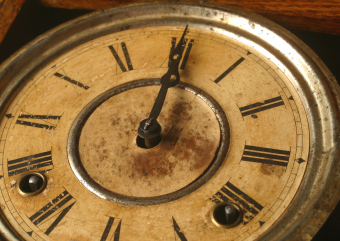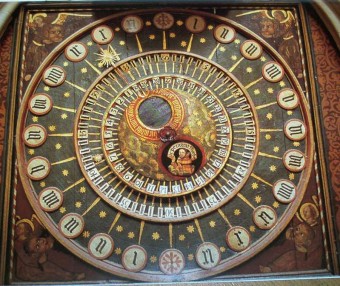Why Clocks Run Clockwise
 Pretty much everyone knows that if you’re asked to pass something clockwise around a table, you hand it to the person on your left because that is the same direction that the hands of a clock move. But what you may not know is that this standard direction is a function not only of timekeeping, but the Earth’s rotation and the happy accident that much of human civilization evolved in the Northern Hemisphere.
Pretty much everyone knows that if you’re asked to pass something clockwise around a table, you hand it to the person on your left because that is the same direction that the hands of a clock move. But what you may not know is that this standard direction is a function not only of timekeeping, but the Earth’s rotation and the happy accident that much of human civilization evolved in the Northern Hemisphere.
If you could look directly at the North Pole from space, it would appear to spin counterclockwise. Given that spin, when a stick is placed in the ground parallel to the Earth’s axis in, say, Egypt, the shadow cast by the stick as the Sun moves across the sky will move in a clockwise direction (notably, a similarly placed stick in Australia would cast a shadow that moves counterclockwise).
As far back as when the ancient Egyptians and Babylonians were fashioning their first shadow clocks (~3,500 BC), the measurement of time moved in a clockwise direction. Even as more precise timekeeping methods came about, sundials (which began in earnest around 1,500 BC) remained popular throughout the middle ages and beyond, given their simplicity of construction and relative reliability. (In fact, early mechanical clocks were often regularly calibrated to nearby sundials.)

One of the earliest mechanical clocks, the Wells Cathedral Clock in Somerset, was wound by hand from its installation in the late 14th century to 2010, when an electric motor was installed, saving someone having to climb the steps and wind it (~800 revolutions per winding) three times per week.
So, when mechanical clocks were introduced in Europe in the 14th century, their inventors were quite familiar with sundials and the clockwise direction that their shadows moved and marked time. Accordingly, by the end of that century when even cathedral clocks were sporting clock faces, they were made in imitation of their sundial forbears, which included hands that moved in a clockwise direction.
Notably, the word clockwise with its present meaning did not appear in English until the 1870s, with counterclockwise also dating to that decade.
The use of wise to mean a way of proceeding dates back to Old English. Clock isn’t nearly so old, and dates to the invention of our modern mechanical clocks (14th century). It is thought to come from either clokke (Middle Dutch), cloque (Old North French) or clocca (Medieval Latin) which all meant bell. Some of the earliest mechanical clocks were simply designed to strike a bell at set intervals, perhaps to announce prayer times or the like, or simply ring on the hour, with these early clocks not necessarily having any faces. And if you’re curious, before they were called “clocks,” these early mechanical clocks were called horologia, from the Greek for “hour” (ὡρα) and “to tell” (λέγειν).
If you liked this article, you might also enjoy our new popular podcast, The BrainFood Show (iTunes, Spotify, Google Play Music, Feed), as well as:
- The Surprisingly Interesting Reason Grandfather Clocks are Called That
- Why We Say “O’Clock”
- How Did People Accurately Keep Track of Time and Keep Appointments and the Like Before Ubiquitous Clocks?
- Why We Divide the Day Into Seconds, Minutes, and Hours
- Why Do Screws Tighten Clockwise?
Bonus Facts:
- Ever wonder what a.m. and p.m. stand for? Well, wonder no more: a.m. stands for “ante meridiem”, which is Latin for “Before Midday”; p.m. stands for “Post Meridiem”, which is Latin for “After Midday”.
- In 2015, it was reported that scientists at the RIKEN Centre for Advanced Photonics created a clock that is so accurate it will not lose even one second of time for another 16 billion years. Likely expensive to build, it consists of “super-cooled atoms held within a lattice of laser beams.”
- The world’s largest clock face is at Abraj Al Bait Towers in Mecca, Saudi Arabia and it boasts a 43 meter diameter. The world’s largest stone sundial is at Jantar Mantar in Jaipur, Rajasthan, India. Part of a collection of nineteen astronomical instruments, the sundial, called Samrat Yantra (or Supreme Instrument), stands 27 meters tall and measures time in two-second intervals.
- The Tower of the Winds in Athens, which lies right under the Acropolis, is thought to be the first clock tower in history, constructed sometime between the 2nd century BC to 50 BC. It contained eight sundials and a water clock, along with a wind vane.
- The International Space Station orbits about 354 kilometers (220 miles) above the Earth and travels at approximately 27,700 km/hr (17,211 mph); so it takes about 92 minutes to circle the Earth once. For this reason, every 45 minutes the astronauts on-board see a sunrise or a sunset, with a total of 15 – 16 of each every 24 hours.
- The record for longest time holding one’s breath under water is currently held by Aleix Aegura of Spain, set on February 28, 2016 at an astounding 24 minutes and 3 seconds. However, that was with the aid of being able to breathe pure oxygen for up to 30 minutes prior to holding his breathe. The record for non-oxygen assisted breath-holding under water is held by Branko Petrović of Dubai who managed an incredible 11 minutes and 54 seconds. This is accomplished, in part, thanks to an innate dive reflex that automatically slows one’s heart rate and metabolism during a dive; while an untrained person’s rate might slow by 10-30 percent on average, professional divers can slow their rates by more than 50 percent.
| Share the Knowledge! |
|





You guys are excellent. There are so many things in and around the world which we basically remain unaware of. I got to learn so many things from from your never ending stuff. Well Done
A simpler method (in the northern hemisphere), go outside, face south, point at where the sun rises, your arm will move in a clockwise direction as you move it toward the sunset.
I have a problem with the sundial explanation. It’s true that horizontal sundials in the northern hemisphere have shadows running clockwise. But that’s not the case with vertical-face sundials – the shadow moves anticlockwise on those. And surely the first mechanical clocks had vertical faces.